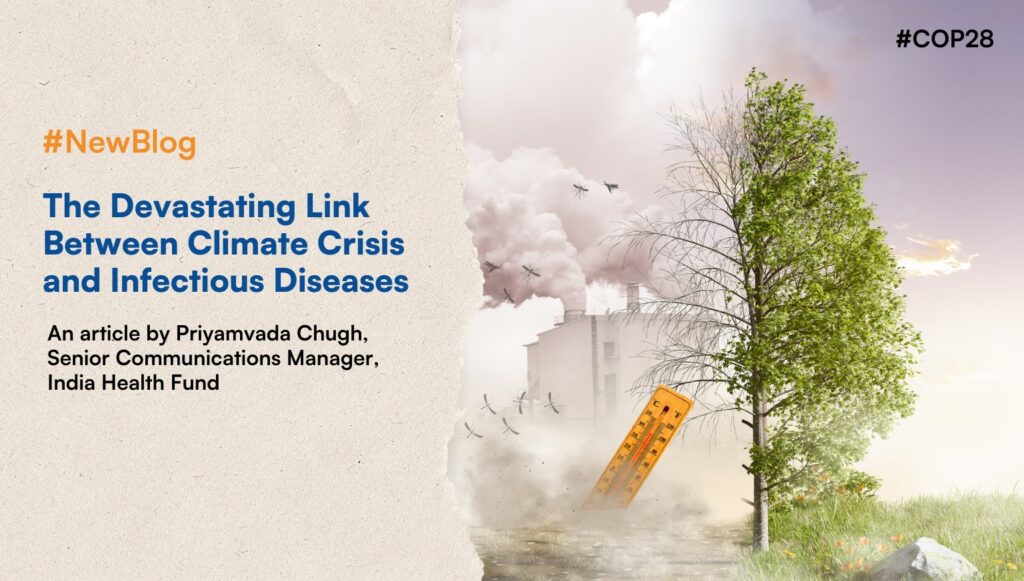

Swarms of Aedes aegypti, a warm-temperature-adapted mosquito flying over the northern most once snow-sprinkled villages near the North Pole, spreading malaria, dengue and chikungunya in remote populations that haven’t even heard of the disease, challenging health practitioners and health systems with pathogens unknown to them – all these could become reality in no time from now. And this is just one example of the devastating link between climate change and the widening spread of infectious diseases.
According to the World Economic Forum, Climate change can worsen more than half, precisely 58% of human infectious diseases[1] — from spread of hepatitis linked to flooding[2], to increased lifespans of mosquitoes carrying malaria due to warmer temperatures[3], to droughts that bring hantavirus-infected rats to human colonies in search of stored grains, to extended wet periods that facilitate increased rat populations[4]. And this doesn’t even account for the unknown diseases and pathogens yet to emerge due to climate-linked changes. For instance, thawing of the permafrost is already unearthing viruses that were once frozen in time, opening a pandora’s box of pathogens[5],[6]. And this has already started. In 2016, a 12-year-old in Siberia died of anthrax that was thawed from a reindeer carcass frozen deep below the snow[7]. The re-emerged disease sickened over 90 people and killed over 2000 reindeers. Studies are also warning the possible release of antibiotic-resistant bacteria owing to the melting permafrost[8].
While data is still emerging and studies are underway, according to one report, the largest number of diseases aggravated by climate change involved transmission by vectors such as mosquitoes[3]. Atmospheric warming or changes in rainfall patterns such as flooding and extended monsoons are altering transmission dynamics, breeding patterns, geographical range and feeding habits of mosquitoes, and thus the incidence of mosquito-borne diseases. One meta-analysis showed that overall, a 1°C rise in temperature is associated with a 13% increase in risk of dengue occurring[9]. Earth’s temperature is already 1.15°C above the 1850–1900 average[10]. A Lancet study has found that by 2070 the population at risk of malaria and dengue fever may increase by up to 4.7 billion additional people, relative to 1970–99[11]. Anopheles stephensi, a type that can carry multiple malarial parasites – plasmodium falciparum and vivax – at the same time, which was largely found in Asia, is now spreading to East and West Africa[12]. By 2050, the two main disease-spreading mosquitoes – Aedes aegypti and Aedes albopictus — will significantly expand their distribution, posing a threat to half the world[13].
Climate crisis is also indirectly impacting infectious diseases by altering human behaviours. For example, during heatwaves people tend to spend more time in water, leading to increased water-borne diseases. Cases of Vibriosis increased following periods of heatwaves in Sweden and Finland in 2014[14]. Climate-related hazards are also altering disease burden by weakening immunity, through malnutrition for example, making people more susceptible to infectious diseases like tuberculosis[15].
The infectious disease argument for climate action has not been clearer.
On one hand, we need to put all forces forward to lower the pace of advent of climate crisis by cutting down greenhouse gas emission. On the other, we need to tackle the hazard at hand. The toll of infectious diseases linked to prolonged heatwaves, flooding, severe storms is rising by the day. We need to put immediate brakes to nip them in the bud. Below are three actionable steps:
Impact of climate change on rising burden of infectious diseases must also be tackled by strengthening health systems through making better diagnostics available to people, especially the underserved, right where they need them. Because just like COVID-19, the climate emergency will hit everyone, but it will impact the vulnerable and the marginalized first and hardest. Point-of-care diagnostic tools, faster active case finding and digital screening solutions must be accessible and available to everyone, everywhere at minimal costs, to cut down the time and cost linked to disease detection and treatment – both for patients and for health systems.
The recent crisis of COVID-19 and monkeypox were likely of zoonotic origin. There is an increasing consensus among the community that addressing human health issues must go hand-in-hand with animal health and environmental health. A unified “One Health” approach that values interconnectedness is a must if we are to comprehensively mitigate the impact of climate change on infectious diseases and prevent any linked future pandemics.
Science and tech-backed innovations have the potential to address each of these above measures – stronger surveillance, better diagnostics and One Health approach. However, funding for the development and deployment of such innovations have often fallen short. Financing the development and deployment of tools that can check infectious diseases quickly and effectively will help us in a big way in tackling this human face of climate change. Funding pandemic preparedness and health systems strengthening must also take a front seat.
Strong partnerships will be the second key enabler. The mammoth task will need all stakeholders – from governments and NGOs, to private entities and communities, to collectively reinforce health systems with better tools and better prepared workforce. “Bringing together the right actors to establish integrated approaches for adaptation” is one of the key pillars laid by the WHO for building climate resilient health systems[17].
As the world gears up for the UN Climate Summit (COP28), where for the very first time in 28 years there will be a whole day on climate change’s impact on health, bringing these issues to the table will be key to making COP28 a success. Lacking which, the linked costs and consequences – for health and economics – will be hard to bear.
Priyamvada Chugh is a Senior Communications Manager at India Health Fund, a Tata Trusts initiative. A cancer biology researcher by training, Priyamvada has manoeuvred into public health communications owing to the power that effective communications holds for the health domain.
1. Climate change is making infectious diseases worse for humans | World Economic Forum (weforum.org)
2. https://bmcinfectdis.biomedcentral.com/articles/10.1186/s12879-020-04961-4
3. https://www.thelancet.com/journals/lanplh/article/PIIS2542-51962100132-7/fulltext
4. https://www.ncbi.nlm.nih.gov/pmc/articles/PMC8778283/
5. Viruses in permafrost: Scientists have revived a ‘zombie’ virus that spent 48,500 years frozen | CNN
6. ‘Zombie’ viruses are thawing from melting permafrost in Russia – The Washington Post
8. Emergent biogeochemical risks from Arctic permafrost degradation | Nature Climate Change
9. Dengue fever: the impact of increasing temperatures and heatwaves – eBioMedicine (thelancet.com)
15. Undernutrition and Tuberculosis: Public Health Implications – PMC (nih.gov)
16. Climate-proofing a malaria eradication strategy | Malaria Journal | Full Text (biomedcentral.com)